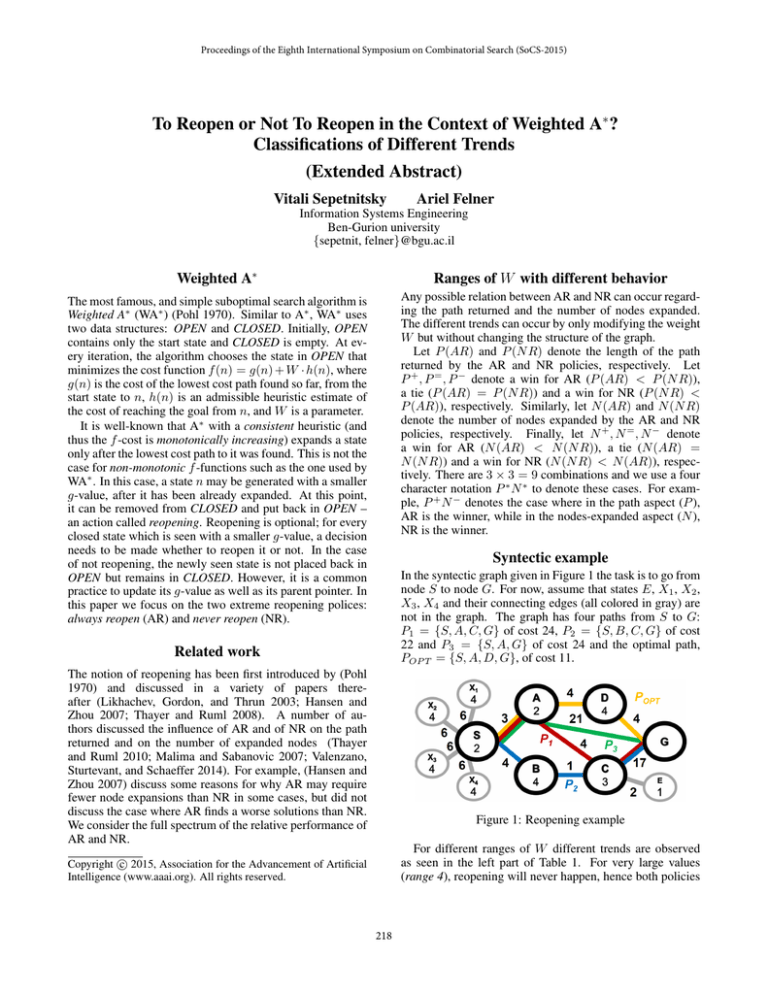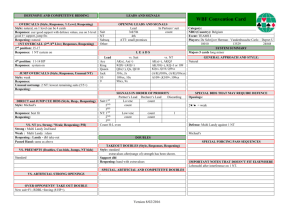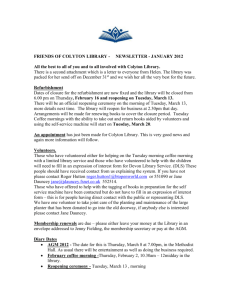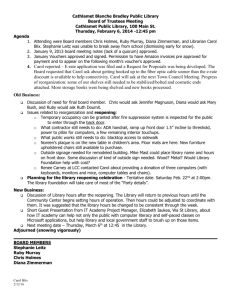
Proceedings of the Eighth International Symposium on Combinatorial Search (SoCS-2015)
To Reopen or Not To Reopen in the Context of Weighted A∗ ?
Classifications of Different Trends
(Extended Abstract)
Vitali Sepetnitsky
Ariel Felner
Information Systems Engineering
Ben-Gurion university
{sepetnit, felner}@bgu.ac.il
Weighted A∗
Ranges of W with different behavior
The most famous, and simple suboptimal search algorithm is
Weighted A∗ (WA∗ ) (Pohl 1970). Similar to A∗ , WA∗ uses
two data structures: OPEN and CLOSED. Initially, OPEN
contains only the start state and CLOSED is empty. At every iteration, the algorithm chooses the state in OPEN that
minimizes the cost function f (n) = g(n) + W · h(n), where
g(n) is the cost of the lowest cost path found so far, from the
start state to n, h(n) is an admissible heuristic estimate of
the cost of reaching the goal from n, and W is a parameter.
It is well-known that A∗ with a consistent heuristic (and
thus the f -cost is monotonically increasing) expands a state
only after the lowest cost path to it was found. This is not the
case for non-monotonic f -functions such as the one used by
WA∗ . In this case, a state n may be generated with a smaller
g-value, after it has been already expanded. At this point,
it can be removed from CLOSED and put back in OPEN –
an action called reopening. Reopening is optional; for every
closed state which is seen with a smaller g-value, a decision
needs to be made whether to reopen it or not. In the case
of not reopening, the newly seen state is not placed back in
OPEN but remains in CLOSED. However, it is a common
practice to update its g-value as well as its parent pointer. In
this paper we focus on the two extreme reopening polices:
always reopen (AR) and never reopen (NR).
Any possible relation between AR and NR can occur regarding the path returned and the number of nodes expanded.
The different trends can occur by only modifying the weight
W but without changing the structure of the graph.
Let P (AR) and P (N R) denote the length of the path
returned by the AR and NR policies, respectively. Let
P + , P = , P − denote a win for AR (P (AR) < P (N R)),
a tie (P (AR) = P (N R)) and a win for NR (P (N R) <
P (AR)), respectively. Similarly, let N (AR) and N (N R)
denote the number of nodes expanded by the AR and NR
policies, respectively. Finally, let N + , N = , N − denote
a win for AR (N (AR) < N (N R)), a tie (N (AR) =
N (N R)) and a win for NR (N (N R) < N (AR)), respectively. There are 3 × 3 = 9 combinations and we use a four
character notation P ∗ N ∗ to denote these cases. For example, P + N − denotes the case where in the path aspect (P ),
AR is the winner, while in the nodes-expanded aspect (N ),
NR is the winner.
Syntectic example
In the syntectic graph given in Figure 1 the task is to go from
node S to node G. For now, assume that states E, X1 , X2 ,
X3 , X4 and their connecting edges (all colored in gray) are
not in the graph. The graph has four paths from S to G:
P1 = {S, A, C, G} of cost 24, P2 = {S, B, C, G} of cost
22 and P3 = {S, A, G} of cost 24 and the optimal path,
POP T = {S, A, D, G}, of cost 11.
Related work
The notion of reopening has been first introduced by (Pohl
1970) and discussed in a variety of papers thereafter (Likhachev, Gordon, and Thrun 2003; Hansen and
Zhou 2007; Thayer and Ruml 2008). A number of authors discussed the influence of AR and of NR on the path
returned and on the number of expanded nodes (Thayer
and Ruml 2010; Malima and Sabanovic 2007; Valenzano,
Sturtevant, and Schaeffer 2014). For example, (Hansen and
Zhou 2007) discuss some reasons for why AR may require
fewer node expansions than NR in some cases, but did not
discuss the case where AR finds a worse solutions than NR.
We consider the full spectrum of the relative performance of
AR and NR.
Figure 1: Reopening example
For different ranges of W different trends are observed
as seen in the left part of Table 1. For very large values
(range 4), reopening will never happen, hence both policies
c 2015, Association for the Advancement of Artificial
Copyright Intelligence (www.aaai.org). All rights reserved.
218
Range
1
Path returned
AR
NR
P
W
1 ≤ W < 3.75
2
3.75 ≤ W
3
4.25 ≤ W < 5
4
< 4.25
5≤ W
POP T POP T P
P2
=
POP T P −
P2
P3
P+
P3
P3
P=
Subrange
1a
1b
2a
2b
3a
3b
4
Nodes Expansions
Case
W
P =N =
1≤ W <3
P =N −
3 ≤ W < 3.75
P − N − 3.75 ≤ W < 4
P −N +
4 ≤ W < 4.25
P + N + 4.25 ≤ W < 4.5
P + N − 4.5 ≤ W < 5
P =N =
5≤ W
Xi
both
both
both
NR
NR
None
None
AR
11
13
12
8
8
8
5
NR
11
11
11
11
10
6
5
Table 1: The path and expansions for different values of W in Figure 1
100
90
80
1000 70
60
50
40
30
20
10
0
% Instances
tie. For very small values (range 1), reopening will make
no difference as the optimal path (POP T ) will be returned
anyway – again a tie. The interesting cases are in the middle
range. For range 3, AR will result in a better path. This
is the intuitive case where AR is expected to be better, or
at least no worse than NR (if ranges 1 and 4 are considered
too). The somewhat counter-intuitive case is range 2, where
AR finds a better path (P2 ) and halts, while the path that
NR has (P3 ) is not strong enough, forcing NR to continue
searching and eventually finding the optimal path (POP T ).
By considering the grayed states and edges of the graph
we can enrich the ranges of W to also have different tendencies in the node expansions. This update allows us to divide
the four ranges mentioned above into subranges, depicted
in the right part of Table 1. Thus, we have 6 out of the 9
possible cases in P ∗ N ∗ .
P+N-,=
P=N-,=
P+,=N+
P-N-,=
P-N+
1.5
2
3
5
10
20 30
W values
50
100 200 500 1000
Figure 2: % instances per class, 15-puzzle
solution of lowest cost (min-cost oracle) or alternatively of
the minimal number of nodes (min-expansions oracle). In
our experiments the min-cost oracle found shorter solutions
of length which was up to 17% shorter than the best solution
found by the best extreme policy. Similarly, we have found
instances where the min-expansions oracle expanded only
60% of the nodes expanded by the best extreme policies.
Experimental results
We experimented with the 8-puzzle, and the 4x4 15-puzzle
with the Manhattan distance heuristic. For each puzzle we
generated 1000 random instances and used a range of values for W . Figure 2 shows the percentage of 15-puzzle instances, partitioned into five disjoint groups according to the
cost of the found path. The figure highlights the “anomalies”
(bottom three slices), or the counter intuitive cases – when
NR finds a strictly better path than AR (P − ) and when AR
expands strictly less nodes than NR (N + ). Our results show
that for some values of W these full-dominance cases occur
in a non-negligible percentage of the instances. This calls for
a method for predicting which reopening policy to use. We
also experimented with 4-connected grid-based maps and
observed similar trends.
Future work
This is a work in progress. Based on our oracle experiments our research now focuses on finding reopening policies smarter than the extreme AR and NR. Such policies
probably should use the current state of the search (e.g. the g
and h value of the state being reopened, the current number
of expansions etc.) and try to predict at each decision point,
whether reopening should be done.
References
Hansen, E. A., and Zhou, R. 2007. Anytime heuristic search.
Journal of Artificial Intelligence Research (JAIR) 28:267–297.
Likhachev, M.; Gordon, G. J.; and Thrun, S. 2003. ARA*: Anytime A* with provable bounds on sub-optimality. In NIPS.
Malima, A., and Sabanovic, A. 2007. Motion planning and assembly for microassembly workstation. In ISCO, 467–474.
Pohl, I. 1970. Heuristic search viewed as path finding in a graph.
Artificial Intelligence 1(3-4):193–204.
Thayer, J. T., and Ruml, W. 2008. Faster than weighted A*: An
optimistic approach to bounded suboptimal search. In ICAPS.
Thayer, J. T., and Ruml, W. 2010. Anytime heuristic search:
Frameworks and algorithms. In SOCS.
Valenzano, R. A.; Sturtevant, N. R.; and Schaeffer, J. 2014. Worstcase solution quality analysis when not re-expanding nodes in bestfirst search. In AAAI, 885–892.
Better polices
AR and NR are extreme policies – either always or never reopen nodes. One can implement a hybrid policy that chooses
to reopen some nodes while bypassing reopening in other
nodes. To demonstrate the potential of such hybrid policies
we implemented a reopening oracle, as follows. Given an
instance to be solved by WA∗ , for every state in CLOSED,
which is generated again with a smaller g-value, a decision
needs to be made whether to reopen it or not. By marking
positive decision (to reopen) by 1 and negative decision (not
to reopen) by 0, a sequence of reopening choices can be described as a binary vector. An oracle simulates the decisions
imposed by all the possible binary vectors and then returns
the sequence of reopening choices that results in finding a
219




